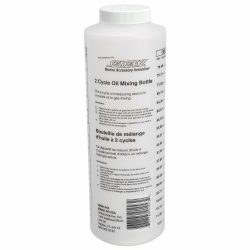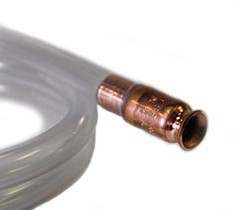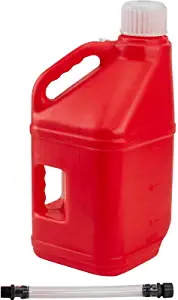New paramotor assembly guide
by Had Robinson
Purchased a paramotor? Pilots need to be careful that it is ready to operate. Failure to follow the proper steps can ruin an engine. This checklist is works for most paramotors. If you have any questions about how to prepare and run your new engine, check with your dealer.
WARNING: NEARLY ALL PARAMOTORS ARE TWO-STROKE ENGINES AND MUST HAVE OIL MIXED WITH THE FUEL! YOU WILL QUICKLY DESTROY YOUR ENGINE IF YOU DO NOT MIX THE CORRECT AMOUNT OF OIL WITH THE GASOLINE!
A. Fuel equipment
Mixing bottle Here is good one from Shoreline Marine and is sold by Sports Academy and others. It is simple, well marked, and can be sealed to keep dirt out, unlike some others. Do not use an open mixing container. It will collect dirt quickly which will end up in your filters. Clogged fuel filters are one of the easier ways to lean out your engine and burn it up. Clean and pure fuel is essential to the best engine performance and longevity.

Siphon A fuel siphon is the easiest way for getting fuel into and out of a paramotor fuel tank. Why remove fuel from a tank? If you are not going to fly for a few weeks, the presence of fuel anywhere in the system may cause problems, especially if it is ordinary vehicle gasoline containing ethanol. FRESH FUEL AND OIL MIX IS CRITICAL TO ENGINE PERFORMANCE AND LONG LIFE. Fortunately, old unleaded gasoline mixed with oil can be harmlessly burned in an automobile rather than disposed of in some other manner. A siphon is a handy way to move fuel around safely.
Academy Sports and Bikemaster have these available. The secret of these
siphons is that they do not require sucking on the hose. The siphon is started by jiggling the end up and down, which starts the siphon. The dinky siphons at Walmart
would take 20 minutes to fill your tank.  The Chinese knock-offs available at Harbor Freight do not have the right kind of hose and will kink and collapse once the siphon is started. Furthermore, the jiggle valve at the end is
inferior. The better quality siphons have a much better jiggle valve and
a hose which will last years. However, if you must use ethanol fuels, any hose will only last a couple of years before it stiffens up. Replacement vinyl tubing for the siphons can be purchased from
any hardware store. It also a good idea to store the siphon in a cloth bag as it keeps dirt out of your fuel. The filters in paramotors (if they are any good) clog easily. Harbor
Freight has a battery operated siphon that is reported as being easy to use and handy.
The Chinese knock-offs available at Harbor Freight do not have the right kind of hose and will kink and collapse once the siphon is started. Furthermore, the jiggle valve at the end is
inferior. The better quality siphons have a much better jiggle valve and
a hose which will last years. However, if you must use ethanol fuels, any hose will only last a couple of years before it stiffens up. Replacement vinyl tubing for the siphons can be purchased from
any hardware store. It also a good idea to store the siphon in a cloth bag as it keeps dirt out of your fuel. The filters in paramotors (if they are any good) clog easily. Harbor
Freight has a battery operated siphon that is reported as being easy to use and handy.
Tanks Ordinary gasoline tanks are annoying because they have all kinds of complex safety features that not only change every few years due to lawsuits (so inner-city
idiots have more trouble blowing themselves up) but also leak or malfunction and then leak like crazy. Unrated and simple
racing fuel containers can be used instead.
 It is important to have (2) tanks. One should be (5) gal and the other (2) gal. This is because you should not store gasoline mixed with oil
more than a week or two. The additives in gasoline, especially ethanol (if present), can affect the lubricating properties of the oil. Stale fuel is an important contributor to overheating and bearing failure in (2) stroke engines.
Our shop table is lined up with burned-up engines caused by pilot carelessness with regards to fuel age, purity, and quality.
It is important to have (2) tanks. One should be (5) gal and the other (2) gal. This is because you should not store gasoline mixed with oil
more than a week or two. The additives in gasoline, especially ethanol (if present), can affect the lubricating properties of the oil. Stale fuel is an important contributor to overheating and bearing failure in (2) stroke engines.
Our shop table is lined up with burned-up engines caused by pilot carelessness with regards to fuel age, purity, and quality.
Note: If you use plastic jugs, especially clear ones, store them in a cool, dark place.
Labels I label all of my tanks with a removable tag. I use a piece of masking tape on my (5) gallon tanks to indicate what kind of fuel it is and when it was purchased. I have thin plywood tags with strings that I put on the (2) gal tanks to indicate the fuel/oil mix ratio. Questions like, "Is my gasoline too old to use?" and "I can't remember whether this is 2.0% or 2.5%?" should never be asked. If you do, you are headed for trouble with your engine. I repeatedly have to remind pilots: paramotors are NOT lawnmower engines. Unless you have unlimited funds, you better take care of them!
Fuel/oil specifications Here are the mix ratios and fuel/oil specifications for various paramotors.
B. CHT
All pilots should install a CHT (cylinder head temperature gauge) and a tachometer/hour-meter on their engines. The Top 80 and most other engines with the Miniplane frame require the TTO sensor extension #V300-24. Miniplane-USA has these items. A CHT will alert pilots to pending problems with their engines, especially the number #1 killer of all paramotors: overheating. The number #2 killer is failure to mix 2-cycle oil with the fuel, use the correct ratio and type of oil. A CHT will not let you know if the fuel has no oil mixed with it. Increasing the oil to fuel ratio does nothing to help extend engine life and may, in fact, ruin it as noted by the engine manufacturers i.e. it effectively leans out the mix and cause engine seizure. Avoid ethanol fuels if at all possible as they tear up the insides of diaphragm carburetors and quickly harden fuel tubing. (For additional reasons why, see the detailed fuel & oil specifications page.)
C. Threadlock
Manufacturers often do not apply threadlock to critical fasteners. Make sure that the following have BLUE threadlock applied:
- Engine frame button-head screws – the screws that fasten the rubber mounts to the engine and to the frame are critical fasteners and must have threadlock applied
- Exhaust port nuts
- Muffler rubber mount button-head screws
- Screw-on terminal on TOP of the spark plug (use RED threadlock). The terminal will loosen, even if tightened with a pair of pliers, if threadlock is not used. Note: This
terminal always comes attached and must first be unscrewed with pliers in order to apply the threadlock.
- Reed valve block mounting screws For the Top 80 and all engines that use the WG carburetor with an internal pulse port through the reed valve body – A reed valve block leak will cause the fuel pump to fail or pump poorly. The carburetor will have to be removed to do this. Pilots cannot be sure that the factory either torqued these screws properly or used threadlock on them.
Note: always apply RED threadlock to studs e.g. the exhaust port studs, the muffler mounting studs (if used), and the redrive studs (if used).
D. RTV sealant
When assembling a new paramotor, there is only one place where it should be used and this is the exhaust flange gasket surface next to the cylinder head. Note: not all motors have this gasket. The best RTV to use in this hot area is the "Permatex Ultra Grey". It is available at all auto parts stores. Go to this page for more detail on the copper gasket for the Top 80, others are similar. Do NOT apply sealant on the exhaust pipe side of the Top 80 copper gasket but only on the cylinder side. Non-copper gaskets which seal non-spring loaded parts should have sealant on BOTH sides of the gasket e.g. the Polini Thor models. DO NOT APPLY SEALANT OF ANY KIND BETWEEN OR ON SPRING-LOADED SURFACES OF THE EXHAUST SYSTEM. Her are some important tips on using RTV. It is NOT as simple as most think.
E. Assembly
1. Assemble the paramotor according to any instructions received. If there are not any, this assembly video for a Miniplane Polini will help. Be sure to install the propeller in the correct position. I recommend doing a compression check on your new engine and record it in a log. That way, you can periodically evaluate the actual condition of the important mechanical parts of your engine.
2. Redrive If there is a redrive on the motor, be certain that it is filled with the correct type and quantity of oil. If this is not done, the seals, gears, and bearings on the redrive will be quickly ruined. Be sure to change the oil after the first (10) hours of use and every year thereafter. Engines with wet-clutches should have the oil changed every 25 hours or less because of the clutch particles that quickly contaminate the lubricating oil. Oil is cheap compared to the cost of fixing a damaged redrive.
3. Wear areas There are (2) areas where serious wear occurs during operation. Unfortunately, Miniplane does not provide any protection to these surfaces.
a. Throttle cable Be sure to wrap black electrical tape or, better, split some black rubber tubing held with zip ties around the throttle cable wherever it contacts the engine frame. If you do not do this, the cable will gradually wear away and a.) jam/break the inner throttle cable and/or b.) short the kill switch wire. There are also important modifications to the cable that may be done to increase longevity and ease of removal.
b. Side stick protection If you have the Miniplane ABM frame, the side bars will constantly rub and grind away at the (2) upper side sticks where they screw into the frame. Use a piece of automotive heater hose to protect the surfaces.
4. Loose side sticks The side sticks will loosen and may come out of their sockets after a dozen or so hours. You should monitor whether the sticks are loosening by putting a dab of bright nail polish at the joint. Any movement will be quickly noticeable.
If you do notice a stick loosening, take a piece of electrical tape and wrap it around the joint. DO NOT USE THREADLOCK ON THE SIDE STICKS!
5. Prime the carburetor If this technique is used, the engine will start the first time, every time. If the carburetor does not have a priming lever, use the end of cotton swab that has had the cotton removed. Sticking a metal object into the metering lever diaphragm could injure it. A properly primed engine will rarely need choke except when pilots start their engines while flying and cannot prime them.
6. Safe operation area Avoid running the engine on the ground unless it is grass or clean concrete. The WORST environment is a beach. SAND RUINS PARAMOTORS. Sand gets sucked into the engine and chews up propellers. Smart pilots will launch from grassy or concrete areas. If you have to launch from the beach, use only enough throttle to get airborne.
7. Adjust hang points It is NOT safe to fly your paramotor until you hang it up, sit in the seat, and check the position of the propeller. It should be close to vertical, the top slightly tilted back a 5 or 10 degrees. If it is tilted forward, the thrust of the engine will fight the lift of the wing. If it is tilted too far back, move the hang point collets to the rear. The Miniplane side bars are shaped differently on each side to help offset torque from the engine. See this page for the details on adjusting the hang points on the Miniplane frame.
8. Adjust carburetor After the engine starts, let it warm up to 70C or more (you do have a CHT installed, right?) and adjust the carburetor per these instructions for your particular altitude and environment (humid or dry).
9. Break-in period New engines should be broken-in properly and then only flown for short periods, avoiding full throttle until a full tank of fuel has been consumed.
10. Test fly the engine. If there are any problems, read this section on performance issues.
Italian quality control is poor and about 1 out of 10 paramotors have some significant factory defect, usually correctable with a simple tools. Some defects are serious and the motor must be returned to the dealer who, hopefully, knows how to service the engine he sold. Common issues are: faulty kill switch circuits, loose engine hardwire, lack of sealant between redrive case halves, improperly installed bearing seals, sloppy welds that block frame assembly, defective starters, dead batteries, incorrect netting size, missing parts, bent propeller hubs (from shipping), clutch misalignment and/or internal defects, defective cylinder castings, broken/defective exhaust and throttle springs, lack of threadlock on CRITICAL fittings i.e. studs and button-head screws that hold the engine and exhaust system together, leaking fuel filters, missing fuel filters.
If there are engine running issues, first perform the fuel system test. It is simple test and will rule the most common issues. If the pilot does not want to fix the problem, the results of the test will help the dealer or repair shop. If the fuel system does not pass the quick test, contact the dealer. The engine should be returned for a professional evaluation.
Rarely, Miniplane and others will have an engine that was assembled incorrectly, even damaged and/or missing sealant in critical places. A professional can find the problem and fix it quickly. You can always return the engine to the dealer.
11. Purge the fuel system If the engine will be stored for more than a few weeks, purge the fuel system or drain the fuel tank and run the engine until it stops. If this is not done, the engine may not start again until the carburetor is rebuilt, especially if gasoline with ethanol is used. In any case, carburetors should be rebuilt yearly. Remember that ethanol fuels attack and destroy fuel system parts. Ethanol is also hygroscopic and why it causes serious issues for those who fly in humid environments. Here is a fuel filter that has begun to corrode from water dissolved in the ethanol in gasoline.
![]()




